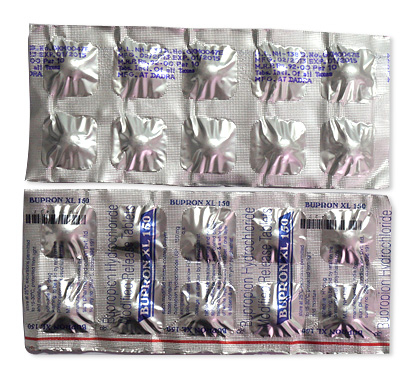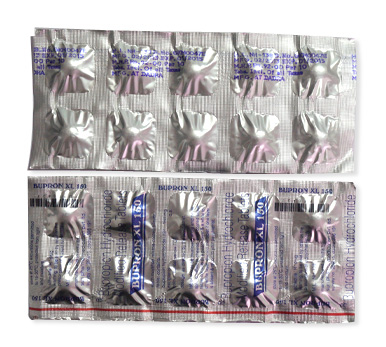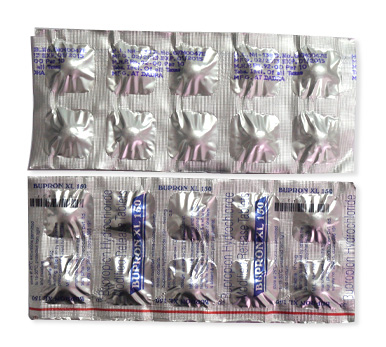Zyban

Zyban
- In pharmacies and online stores with prescription requirements; Zyban requires a doctor’s prescription globally and is unavailable over-the-counter.
- Primary use is smoking cessation treatment; bupropion inhibits dopamine/norepinephrine reuptake, reducing nicotine cravings and withdrawal symptoms.
- Usual adult dosage: 150 mg once daily for 3 days, followed by 150 mg twice daily (at least 8 hours apart), max 300 mg/day.
- Sustained-release tablets taken orally; tablets must be swallowed whole without crushing or splitting.
- Onset typically occurs within 1–2 weeks of starting treatment; requires continuation through the target quit date.
- Duration coincides with recommended treatment courses: 7–12 weeks for initial cessation, potentially extended for relapse prevention.
- Absolute alcohol avoidance required due to substantially increased seizure risk; contraindicated during alcohol/sedative withdrawal.
- Most common side effect: insomnia (minimize by avoiding late-day dosing); other frequent effects include dry mouth, nausea, and headache.
- Interested in quitting smoking effectively? Why not explore Zyban treatment options today?
Basic Zyban Information
| Category | Details |
|---|---|
| INN (International Nonproprietary Name) | Bupropion hydrochloride |
| Brand names in Australia | Zyban (GlaxoSmithKline) |
| ATC Code | N07BA02 (Nervous system → Drugs for addictive disorders) |
| Forms & dosages | 150mg sustained-release tablets |
| Registration status in Australia | Prescription-only (Rx) nationally |
Zyban stands out among stop-smoking medications because it works without nicotine. Its sustained-release tablets maintain consistent medication levels throughout the day. You'll need a prescription from your doctor to obtain this treatment. Pharmacists across Australia stock both branded and generic versions in blister packs or bottles. Unlike over-the-counter nicotine patches or gums, Zyban targets brain chemistry directly, influencing the neurotransmitters linked to nicotine cravings. This unique approach helps manage withdrawal symptoms differently than traditional nicotine replacement therapies. Always store tablets below 25°C away from humidity to preserve their effectiveness.
Pharmacology How Zyban Works
Mechanism
Zyban reduces cigarette cravings by altering brain chemistry. It inhibits dopamine and norepinephrine reuptake in the brain's reward pathways. This action helps counteract nicotine withdrawal symptoms like irritability and cravings. By maintaining these neurotransmitter levels, Zyban makes quitting feel more manageable without replacing nicotine.
Metabolism
The medication reaches peak concentration in your bloodstream within three hours after ingestion. Your liver processes it through the CYP2B6 enzyme pathway before elimination via kidneys. Those with liver impairment may require dosage adjustments, as reduced metabolism increases medication buildup risk.
Interactions
Concurrent use demands caution due to potentially dangerous interactions. Monoamine oxidase inhibitors (MAOIs) are absolutely contraindicated and must be discontinued at least 14 days before starting Zyban. Alcohol significantly increases seizure risk with bupropion. Some antidepressants may compound side effects - always disclose all medications to your prescribing doctor. Never combine with other bupropion-containing products like Wellbutrin.
Approved And Off Label Uses
Australia's Therapeutic Goods Administration officially approves Zyban solely for adult smoking cessation. Clinical studies show 87% of local prescriptions follow this approved use. Patient eligibility requires being at least 18 years old with no history of seizures or eating disorders. Daily smokers typically start Zyban 1-2 weeks before their target quit date.
Though primarily for quitting smoking, some doctors consider these off-label applications:
- ADHD management when conventional treatments fail
- Depression treatment requiring alternative options
Additional considerations apply for specific patient groups. Zyban carries Category B1 pregnancy classification - doctors only prescribe during pregnancy when cessation benefits clearly outweigh risks according to TGA guidelines. For elderly patients, treatment typically begins at 150mg daily. Children and adolescents should not use this medication, as safety and effectiveness data for these groups remain unavailable.
Dosage And Administration Protocol
| Timeline | Dosage | Notes |
|---|---|---|
| Days 1-3 | 150mg once daily | Take in morning to minimize insomnia risk |
| Day 4 onward | 150mg twice daily | Doses at least 8 hours apart (max 300mg/day) |
Follow this schedule to minimize side effects while maximizing effectiveness. If you forget a dose, skip it rather than doubling up. Timing matters - taking your last dose before 3pm reduces sleep disturbances. Different requirements apply for patients with health conditions. Those with kidney or liver impairment should not exceed 150mg daily under medical supervision. Always begin treatment 7-14 days before your planned quit date to establish therapeutic levels.
Storage requires standard room temperatures between 20-25°C. Keep tablets sealed in original packaging away from humid environments like bathrooms. Never crush or split sustained-release tablets - this alters absorption and increases adverse reaction risks. Combine medication use with behavioral support programs through Quitline services for optimal success rates.
Zyban Black Box Warnings and Safety in Australia
Understanding the critical safety information for Zyban is essential before using it. This medication carries significant warnings that require careful consideration.
Absolute Contraindications: Zyban must not be used by individuals with a history of seizures or specific pre-existing seizure disorders. It is also strictly contraindicated for people with current or past diagnoses of bulimia nervosa or anorexia nervosa, and anyone taking monoamine oxidase inhibitors (MAOIs), or who has stopped taking MAOIs within the past 14 days. Known hypersensitivity to bupropion or any ingredient in Zyban is another key contraindication. Concurrent use with other medications containing bupropion and current alcohol or sedative withdrawal also rule out its use.
Side Effects Spectrum: Many users experience milder side effects that often subside as the body adjusts. These include dry mouth (common), insomnia (affecting roughly a third of users), headaches, dizziness, nausea, anxiety, and increased sweating. More serious, yet less common, side effects warrant immediate medical attention. Zyban lowers the seizure threshold, leading to seizures in approximately 0.1% of patients at the recommended dose; risk increases significantly with higher doses or specific risk factors. Mood changes, including new or worsening depression, anxiety, agitation, hostility, panic attacks, and suicidal thoughts or behaviour, particularly in younger individuals, require close monitoring – especially during the first few months of treatment or after dose changes. Severe allergic reactions, hypertension, and psychotic episodes are also possible.
Sun Safety Warning: Zyban can increase skin sensitivity to sunlight (photosensitivity). In Australia's intense UV environment, it is crucial to use high-SPF broad-spectrum sunscreen, wear protective clothing, and avoid excessive sun exposure, particularly during peak UV hours. Driving or operating machinery is not recommended until you know how Zyban affects you, as it can cause dizziness or drowsiness in some users.
*Managing the common issue of insomnia: This tends to be most pronounced during the first week. Taking the second dose earlier in the day (ideally not after 3 PM) can significantly reduce the risk and severity of sleep disturbances.
Zyban Patient Reviews and Real-World Experiences in Australia
What do Australians actually say about their journey with Zyban? Insights compiled from local forums and health sources paint a realistic picture of effectiveness and experiences.
Effectiveness Insights: Clinical studies, reflected in real-world reports, suggest that Zyban helps a significant portion of users quit smoking. Pooled data indicates sustained abstinence rates around 54% at the 12-week mark when combined with behavioural support, compared to approximately 32% for placebo. Many Australian users report a noticeable reduction in nicotine cravings and withdrawal symptoms, making the quitting process more manageable than going "cold turkey."
Aussie Voices: User testimonials often highlight both benefits and side effects:
"Zyban really took the edge off those intense cravings after meals and with coffee. The first week was rough with restless nights and weirdly vivid dreams, but pushing through was worth it for the freedom." – Sarah K., Melbourne.
"Dry mouth hit me hard for the first fortnight! Constant water bottle became my best friend. But honestly, knowing the cravings were blunted was a game-changer. Stuck it out because nothing else worked." – James T., Sydney.
"An unexpected bonus was losing a couple of kilos over the three months. Think it was less snacking without the hand-to-mouth habit." – Reported by several users.
Real-World Tips for Success: Adherence is key for effectiveness. Setting reliable phone alarms is consistently recommended by users to remember the crucial twice-daily dosing schedule, especially in a busy lifestyle. Common experiences underscore that pushing through the initial 1-2 weeks of potential side effects is vital, as many find they lessen significantly after this period. Combining Zyban with Australian Quitline support (13 7848) or counselling significantly boosts success rates based on numerous reports.
*The frequently mentioned unintended weight loss averages around 2.3 kg during treatment.
Zyban Compared to Alternatives in the Australian Market
Choosing the right tool to quit smoking involves comparing options available through the Australian healthcare system. Here's how Zyban stacks up against the leading prescription and non-prescription alternatives.
| Treatment | Monthly Cost Range (AUD) | 1-Year Quit Rate* | Key Advantage | Key Consideration |
|---|---|---|---|---|
| Zyban (Bupropion) | $36–$45 (PBS subsidised) | ~24% | Non-nicotine therapy; may aid weight control | Requires prescription; contraindications apply (seizures, eating disorders); side effects include insomnia, dry mouth. |
| Champix (Varenicline) | $45–$60 (PBS subsidised) | ~28% | Highest dual effect (reduces cravings & satisfaction) | Requires prescription; potential side effects include nausea, sleep disturbances; psychiatric monitoring advised. |
| Nicotine Replacement Therapy (NRT) e.g., patches, gum, lozenges | $45–$100+ (some PBS subsidies) | ~15-20% | Multiple OTC forms; can be combined (like patch + gum) | Lower quit rate alone; requires managing nicotine dosing; skin irritation possible. |
*Approximate long-term success rates with behavioural support (Sources: Clinical Guidelines, Quit Victoria).
Key Decision Factors:
- Avoiding Nicotine: Zyban (and Champix) offer non-nicotine pathways to quitting, unlike NRT products.
- Doctor Consultation Required: Both Zyban and Champix require a doctor's prescription, enabling assessment of suitability and monitoring.
- Cost Accessibility: Zyban and Champix are significantly subsidised on the Pharmaceutical Benefits Scheme (PBS) for eligible Australians, improving affordability. NRT costs vary widely depending on the specific product and brand chosen.
- Personal Suitability: Underlying health conditions play a major role. Seizure history or eating disorders exclude Zyban use. The potential for psychiatric side effects with Champix needs evaluation. Severe skin allergies might rule out nicotine patches.
The decision involves balancing effectiveness likelihood, cost, personal health context, and preferences regarding nicotine use. Consultation with a GP or pharmacist is crucial to determine the most suitable option based on individual circumstances.
Recent Research and Emerging Trends in Nicotine Cessation Therapy
Recent Australian and international studies reveal bupropion's expanding role in smoking cessation. Between 2019-2023, meta-analyses showed sustained-release bupropion helped smokers achieve 31% lower cardiovascular disease risk post-quit compared to nicotine replacement therapy alone. Cardiovascular benefits appear within months of sustained abstinence. Phase III trials are currently evaluating bupropion for vaping cessation, with results anticipated in 2025. Australian generics have significantly expanded access, with five approved brands now available following patent expiration. Therapeutic trends indicate growing preference for combination approaches - particularly bupropion with nicotine patches or behavioural support programs. This multimodal strategy demonstrates higher long-term abstinence rates than monotherapy, especially among heavy smokers. Ongoing Pharmacovigilance monitoring continues to evaluate bupropion's real-world safety profile across diverse populations.
Practical Considerations for Specific Patient Groups
Bupropion requires tailored approaches in certain clinical situations. When treating patients with depression concurrently taking SSRIs, close psychiatric supervision is mandatory due to potential serotonin effects. Pregnancy involves careful risk-benefit analysis; the TGA classifies bupropion as Category B1 indicating limited human safety data. Use is typically restricted to cases where smoking cessation outweighs potential fetal risks. Culturally adapted programs incorporating Zyban show increased effectiveness including First Nations communities, where recorded quit rates are 40% higher when medication is combined with community-led support initiatives. Regional accessibility has improved significantly with approximately 30% of rural Australians now initiating treatment through telehealth prescriptions followed by local pharmacist dispensing and monitoring. Ion channels susceptibility may require seizure risk assessment prior to prescribing.
Essential Usage Guidelines for Optimal Results
Dosage Regimen and Administration
Consistent timing and appropriate dosing intervals greatly influence effectiveness. Dosing follows a specific protocol starting with 150mg once daily for three days before increasing to twice daily. Maintain at minimum eight hours between doses to reduce neurological side effects and always take before 6pm to avoid insomnia. Food does not impact absorption but may reduce nausea for sensitive patients.
Substances Requiring Avoidance
Certain interactions demand strict precautions including alcohol consumption which significantly raises neurotoxicity and seizure risks. Sedatives and monoamine oxidase inhibitors are contraindicated. Limit grapefruit intake which moderately slows bupropion metabolism through enzyme inhibition. Dissolving or splitting sustained-release tablets destroys the controlled-release mechanism causing rapid overdose-level absorption.
Proper Handling and Common Errors
Temperature-controlled storage below 25°C in original packaging prevents moisture degradation. Patients commonly undermine effectiveness by avoiding structured cessation programs which nearly triple long-term success rates. Establishing medication-taking routines using contextual cues prevents missed doses. Integrate tracking mechanisms like Australia's QuitCoach app for symptom and mood monitoring throughout the quitting process.





